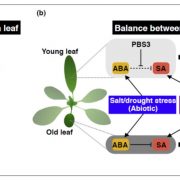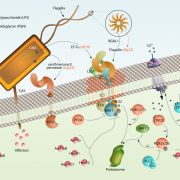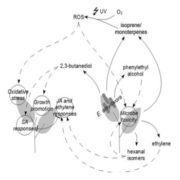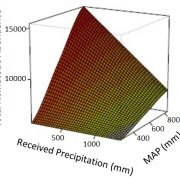A virus-targeted plant receptor-like kinase promotes cell-to-cell spread of RNAi (PNAS) ($)
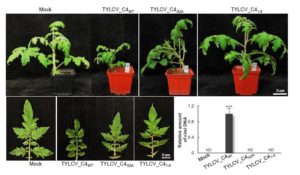 Viruses can move from cell to cell through plasmodesmata. Small interfering RNAs (siRNAs) are key components in the plant’s arsenal against viruses. They function by harnessing the AGO system to target and cleave viral RNA, thus silencing the viruses. Like the viruses they target, siRNAs move from cell to cell through plasmodesmata. Previous work showed that the C4 protein from the Tomato yellow leaf curl virus (TYLCV) can delay the spread of viral silencing. Through some cleverly designed experiments, Rosas-Diaz et al. showed that a previously identified plant protein BAM1 (BARELY ANY MERISTEM 1) binds to the viral C4 protein, and contributes to the spread of siRNAs. The authors propose that the function of the viral C4 protein is support viral pathogenicity by interfering with the spread of silencing siRNAs through an interaction with BAM1. As BAM1 also has a role in development, it will be interesting to determine if its developmental function is also mediated by interaction with small RNAs, which are known to contribute to developmental patterning. (Summary by Mary Williams) Proc. Natl. Acad. Sci. USA 10.1073/pnas.1715556115
Viruses can move from cell to cell through plasmodesmata. Small interfering RNAs (siRNAs) are key components in the plant’s arsenal against viruses. They function by harnessing the AGO system to target and cleave viral RNA, thus silencing the viruses. Like the viruses they target, siRNAs move from cell to cell through plasmodesmata. Previous work showed that the C4 protein from the Tomato yellow leaf curl virus (TYLCV) can delay the spread of viral silencing. Through some cleverly designed experiments, Rosas-Diaz et al. showed that a previously identified plant protein BAM1 (BARELY ANY MERISTEM 1) binds to the viral C4 protein, and contributes to the spread of siRNAs. The authors propose that the function of the viral C4 protein is support viral pathogenicity by interfering with the spread of silencing siRNAs through an interaction with BAM1. As BAM1 also has a role in development, it will be interesting to determine if its developmental function is also mediated by interaction with small RNAs, which are known to contribute to developmental patterning. (Summary by Mary Williams) Proc. Natl. Acad. Sci. USA 10.1073/pnas.1715556115


